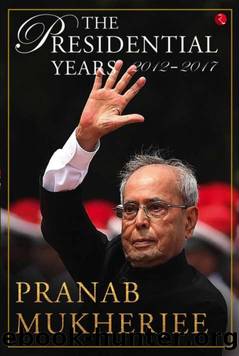THE PRESIDENTIAL YEARS: 2012â2017 by Pranab Mukherjee

Author:Pranab Mukherjee [Pranab Mukherjee]
Language: eng
Format: epub
Publisher: Rupa Publications India Pvt. Ltd.
Published: 2021-01-05T00:00:00+00:00
CHAPTER 8
PRESIDENTIAL VISITS ABROAD: REITERATING FRIENDSHIP AND COOPERATION
A s President of India, my official visits to foreign countries served many purposes. They demonstrated the close bonds of friendship India had with those nations, signalled Indiaâs desire for greater mutual cooperation in varied areas and enhanced the levels of trust and communication. That said, I wanted to limit these visits to a minimum. Before I went on a foreign visit, I used to discuss the issue with the PM. He would send me a letter in which the core points of our bilateral relations were mentioned. It was a practice initiated by PM Modi.
Further, I wished to concentrate on those countries with which India had excellent relationships. On that list, Bangladesh comes first, as a very close and friendly nation. My relationship with Bangladesh developed during the Liberation War of 1971. Even before that, as a student of history, I took keen interest in the political developments within the Muslim League and outside. I also followed the developments in East Pakistan and other parts of Pakistan, including West Punjab, Sindh, North-West Frontier Province and Balochistan. This interest enabled me to play a small role in developing closer links between the two nations. As a minister, I had visited Bangladesh a couple of times. Given my special fondness for the country and understanding of its affairs, I was always involved in IndiaâBangladesh matters, whether in government or outside during the prime ministership of Deve Gowda, I.K. Gujral and Atal Bihari Vajpayee. Thus, even the non-Congress governments consulted me with regard to Bangladesh affairs.
My family and I have had a close, personal relationship with PM Sheikh Hasina since the time she was in exile in the late 70s in New Delhi. With her return to power for a second time, Sheikh Hasina extended full cooperation to India and prevented extremists from the banned United Liberation Front of Asom (ULFA) to carry out its subversive activities while taking shelter in Bangladesh. This cooperation went to the extent of Bangladeshi authorities arresting the outfitâs extremist leader, Golap Baruah alias Anup Chetia, and handing him over to Indian security forces. The Indian government had been trying hard for years to get him extradited. Earlier, Chetia had been arrested by Bangladeshi authorities on a variety of charges, and it was through Sheikh Hasinaâs personal intervention that his extradition became possible. His arrival in India could further isolate the hardline ULFA leader Paresh Baruah, who, Indian authorities felt, had been leaning towards China and persisting with his anti-India activities.
There is, however, one major issue between the two countries that remains unresolved: sharing the waters of Teesta. A short recent history on the subject would be in order to grasp the complication. The Teesta, which originates in the Himalayas, is the lifeline of large parts of north Bengal. Bangladesh has sought an âequitableâ distribution of the water to feed its needs and demands, on the lines of the Ganges Water Sharing Treaty of 1996. The Teesta issue hit a
Download
This site does not store any files on its server. We only index and link to content provided by other sites. Please contact the content providers to delete copyright contents if any and email us, we'll remove relevant links or contents immediately.
Blood and Oil by Bradley Hope(1531)
Wandering in Strange Lands by Morgan Jerkins(1374)
Ambition and Desire: The Dangerous Life of Josephine Bonaparte by Kate Williams(1346)
Daniel Holmes: A Memoir From Malta's Prison: From a cage, on a rock, in a puddle... by Daniel Holmes(1295)
It Was All a Lie by Stuart Stevens;(1265)
Twelve Caesars by Mary Beard(1258)
The First Conspiracy by Brad Meltzer & Josh Mensch(1140)
What Really Happened: The Death of Hitler by Robert J. Hutchinson(1131)
London in the Twentieth Century by Jerry White(1114)
Time of the Magicians by Wolfram Eilenberger(1089)
The Japanese by Christopher Harding(1086)
Twilight of the Gods by Ian W. Toll(1085)
Cleopatra by Alberto Angela(1063)
A Woman by Sibilla Aleramo(1054)
Lenin: A Biography by Robert Service(1046)
The Devil You Know by Charles M. Blow(986)
Reading for Life by Philip Davis(973)
The Life of William Faulkner by Carl Rollyson(925)
1965--The Most Revolutionary Year in Music by Andrew Grant Jackson(924)
